Mobility Enhancement in Heterogeneous Networks
a heterogeneous network and wireless terminal technology, applied in the field of handling the mobility of wireless terminals, can solve the problems of deteriorating reception, affecting the reception, and causing the cell change command (e.g., handover command) transmitted by the lpn to be lost, so as to achieve the effect of reducing at least external interferen
- Summary
- Abstract
- Description
- Claims
- Application Information
AI Technical Summary
Benefits of technology
Problems solved by technology
Method used
Image
Examples
Embodiment Construction
[0040]FIG. 1 schematically Illustrates an example wireless communication network 10 including a first cell 12 served by a low power node (LPN) 14 and a second cell 16 served by a high power node (HPN) 18. Thus, the network 10 is a HetNet. A network node 20 is in communication with each of the LPN 14 and HPN 18. In one or more embodiments, the LPN 14 is one of a home base station, a local area base station and a medium base station, and the cell 12 is one of a femto cell, a pico cell, and a micro cell. In one or more embodiments, the HPN 18 is a NodeB or eNodeB, and the cell 16 is a macro cell. In one or more embodiments the network node 20 is a radio network controller (RNC), base station controller (BSC), relay, or donor node controlling a relay.
[0041]Based on one or more predefined conditions being met, the LPN 14, HPN 18, or network node 20 is operative to delay a cell change of a wireless terminal 22 between the first cell 12 and the second cell 16 (i.e., from the first cell 12 ...
PUM
 Login to View More
Login to View More Abstract
Description
Claims
Application Information
 Login to View More
Login to View More - R&D
- Intellectual Property
- Life Sciences
- Materials
- Tech Scout
- Unparalleled Data Quality
- Higher Quality Content
- 60% Fewer Hallucinations
Browse by: Latest US Patents, China's latest patents, Technical Efficacy Thesaurus, Application Domain, Technology Topic, Popular Technical Reports.
© 2025 PatSnap. All rights reserved.Legal|Privacy policy|Modern Slavery Act Transparency Statement|Sitemap|About US| Contact US: help@patsnap.com



